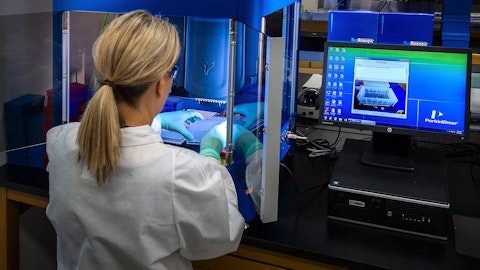Orchard Therapeutics plc (NASDAQ:ORTX) Q2 2023 Earnings Call Transcript August 3, 2023
Operator: Good day and thank you for standing by. Welcome to the Orchard Therapeutic Second Quarter 2023 Earnings Conference Call. At this time, all participants are in a listen-only-mode. [Operator instructions]. Again, please be advised that today’s conference is being recorded. I would now like to hand the conference over to your speaker today. Bobby Gaspar, CEO and Co-founder.
Bobby Gaspar: Hello, everyone. I’m Bobby Gaspar, CEO and Co-founder of Orchard Therapeutics. Welcome to our second quarter 2023 conference call. We’re especially delighted to share with you some important regulatory and business updates, as well as provide our quarterly financial results. Before we get started, I want to remind everyone that throughout this call, we will be making forward-looking statements. Please refer to the supplemental presentation materials and our latest SEC filings for more information. As we’ll highlight on today’s call, Orchard continues to successfully execute across all aspects of our business, including commercial, regulatory, [ph]R&D, as well as operational management. The news we announced this morning reinforces Orchard’s leadership position in the HSC gene therapy field.
I have two members of the leadership team joining me on today’s call. Following my remarks, Frank Thomas, President and Chief Operating Officer, will provide a summary of our momentum in Europe, as well as an overview of our financial results for the quarter. Braden Parker, our Chief Commercial Officer, will also be joining for Q&A. We will keep our prepared remarks focused on three primary topics. First, you’ll hear about the continued progress we are making to advance OTL-200 towards a potential U.S approval. Second, we’ll share updates regarding the commercial momentum we are building in Europe. And third, we’ll provide a general business update and outline our quarterly financial results. Let’s start with an update on the regulatory status of OTL-200 in the U.S.,which is intended for the treatment of early onset Metachromatic Leukodystrophy, or MLD.
In the most severe form of MLD, babies develop normally, in late infancies start to rapidly lose the ability to walk, talk and interact with the world around them. These children may require 24 hours care, and the majority pass away within five years of disease onset, creating an enormous burden on patients, their families and healthcare systems. The medical need is significant, and we are seeing the value of our gene therapy for MLD being recognized by peers throughout Europe, where it has been approved since late 2020. As we announced in this morning’s press release, we have completed the role submission of our PLA to the U.S. FDA for OTL-200, which previously received both rare pediatric disease and RMAT designations from the agency. Orchard has requested priority review, which, if granted, would put OTL-200 on track ,for a potential U.S. approval in the first half of 2024.
Reflecting on the tremendous progress we’ve collectively made in the seven months since our might be clinical meeting with the FDA, I want to take a moment to sincere gratitude to the Orchard team, as well as our clinical collaborators and external partners who contributed to the achievement of this milestone. While there’s still work to be done today, we are one significant step closer to bringing this important therapy to children and their families in the U.S. Living with MLD, who currently have no treatment options beyond supportive care. We are looking forward to working with the agency throughout the filing and review process and expect to hear from the FDA regarding acceptance of the BLA in the third quarter of this year. We’re also planning to present the full OTL-200 BLA clinical data set comprising more than 230 years of patient experience as an upcoming medical meeting.
These data are important because they demonstrate consistent outcomes using an endpoint discussed and agreed with the FDA as being clinically meaningful. Before we discuss our commercial and financial updates, let’s take a moment to highlight some notable data we recently presented from across our HSC gene therapy portfolio, which underscores the transmitted potential of our approach and continues to demonstrate the ability of gene modified HSCs to migrate into multiple organ systems, including bone, CNS and GI-tract, and deliver therapeutic enzymes and proteins locally to affect disease correction. Several presentations demonstrating autumn’s leadership in neurometabolic and CNS disorders were featured at ASGCT in Los Angeles. This included new data from the ongoing Proof-of-Concept study of OTL-203 for patients diagnosed with the Hurler form of MPS-1, which demonstrated extensive metabolic correction in the skeletal system of patients, resulting in normal growth rates, skeletal remodeling, improvement in joint function and progressive mission of motor skills.
The current standard of care for MPS-1 hers is allergenic hematopoietic stem cell transplant, which does not adequately address the growth and skeletal manifestations of the disease, among other clinical outcomes. Orchard plans to initiate a global 40 patient registrational randomized controlled trial of OTL-203 compared to standard of care by year end. We are currently working with the clinical sites, our CROs and decentralized labs to prepare for this first of its kind study. A presentation highlighting updated OTL-201 data from the ongoing proof of concept study in MPS-3 A patients showed additional favorable neurocognitive outcomes, compared to disease natural history, with median follow-up of two and a half years. Similar to MLD, MPS-3 A represents a significant medical need given the disease severity and the fact that there are no approved therapies treatment with allergenic HSCT or enzyme replacement therapy has not been shown to be effective for MPS-3 A.
Patients enrolled in the ongoing proof of concept trial will be followed for a minimum of three years, during which time the study investigators will continue to report additional biochemical and clinical outcomes. We look forward to continuing to follow patients in this study to inform the later stages of development for the program. We also featured the first preclinical data for OTL-204 for the pro-granulum deficient form of frontotemporal dementia, which highlighted the ability of HSC gene therapy to express pro-granulum in the CNS, modulate neuroinflammation and normalize predictive biomarkers. At ASGCT, we also presented preclinical data from two of our in house research programs which demonstrate the broad potential of our platform to address larger indications.
This included preclinical proof of concept data showing the therapeutic potential of OTL-104 for NOD2 Crohn’s disease, a severe and treatment refractory form of the disease. Additionally, in vivo data demonstrated the development of. CAR-Treg cells from genetically engineered HSCs as a potential one time treatment for autoimmune disorders. Together, our rich pipeline continues to provide multiple opportunities for near term data and inflection points, both through internal investment and business development. Moreover, they are all based on the same HSC gene therapy platform as Libmeldy, providing a roadmap and common infrastructure to help us achieve scientific, clinical, regulatory and commercial success. With that, let me turn the call over to Frank to discuss the commercial momentum we are building in Europe with Libmeldy, as well as our quarterly financial performance.
Frank Thomas: Thank you, Bobby. We’ve always believed in the curative potential of HSC gene therapy for severe and other genetic diseases. With the approval and launch of Libmeldy in Europe, we are making that promise a reality for patients with MLD. Our commercial and medical teams continue to work with all members of the MLD, KL and Patient community to identify, refer and support treatment of eligible patients. We also continue to make progress obtaining reimbursed access to Libmeldy in additional European countries. So far in 2023, we have secured reimbursement agreements in four additional European countries exceeding our annual goal in just the first half of this year. Most recently, the Decision Forum for New Approaches in Norway agreed to authorize with MLD for all eligible patients with early onset MLD.
Patients in the country will be referred to the treatment center in Sweden once it’s fully qualified. Reimbursement discussions are ongoing in several European countries. In addition, we have been successful in expanding our commercial reach geographically through early access mechanisms in France, through cross border pathways in Eastern Europe, and through treatment abroad programs in the Middle East, which are important growth drivers during this relatively early stage of launch. To date, we have now treated patients from six different countries on commercial basis at four of our five qualified centers in Europe. We continue to achieve a 100% success rate in drug product production and are confident we can take this commercial model and successfully apply it to the U.S. Following a potential FDA approval for OTL-200.We’ve spoken frequently about the importance of newborn screening to aid early diagnosis and treatment of MLD patients.
To date, nine prospective studies are actively screening newborns for MLD in key regions, countries and states. Four confirmed cases of MLD have been identified following the screening of more than 150,000 newborns globally as of June 30, and many of these MLD patients identified through newborn screening are expected to be treated commercially with Libmeldy in 2023 and beyond. By the end of the year, more than 200,000 newborns are expected to have been screened, creating an opportunity to identify additional patients and adding to the referrals being generated through early symptomatic diagnosis and family screening. Furthermore, the data from these studies will provide critical evidence to support applications for universal screening of MLD in the U.S. and around the world.
On that front., recently, the Illinois State Legislature passed the Newborn Metabolic Screening Act, also known as SB67, which requires the state Department of Public Health to screen all newborns for MLD. The bill was signed by the governor last week, and it is expected that Illinois will start the process of implementing statewide screening for MLD this year. This represents the culmination of a multistakeholder initiative working together to support screening for MLD and a very big step forward for newborn screening in the U.S., where we are actively laying the groundwork for the implementation of MLD screening programs in other states. In addition, following the previously announced positive identification of a newborn with MLD in Germany from a prospective study, the necessary steps are being taken to apply for nationwide screening in that country.
The other patients who have been identified through these studies in Germany have either been treated with Libmeldy, are scheduled for treatment in future quarters, or are continuing to be evaluated to determine appropriate treatment options. Beyond identifying treatment eligible patients and supporting efforts to advance universal screening, these research studies also help elucidate the true incidence of MLD, which we believe represents a significant annual global market opportunity. Using an estimated incidence rate of one per 100,000 live births cited in existing literature, and applying today’s average per patient net price realized since the European launch, we project the potential market opportunity for Libmeldy in the U.S. and Europe alone to be more than $200 million annually.
Applying those same assumptions to the potential addressable worldwide market, the global opportunity for Libmeldy could reach up to $500 million annually, considering countries where we believe therapies like Libmeldy will be reimbursed. This peak opportunity will only be realized if universal newborn screening is in place, enabling the incidence population to be identified prior to the onset of symptoms. While this can take time, the momentum we’re seeing with the entire MLD community coming together can make it a reality. The data from these newborn screening studies are still early to draw definitive conclusions. However, preliminary findings suggest that the incidence could be closer to one in 50,000 live births, and consequently, the commercial opportunity may be even higher than previously estimated in the literature.
This could create a market opportunity exceeding $1 billion per year globally. The commercial potential and longevity of Libmeldy is further bolstered by its long term durable clinical impact. Also the high barriers to market entry and the fact that there are currently no other approved therapies or clinical candidates in development following the recent news of the discontinuation of other programs. Now turning to our financial performance, it has been another quarter of solid execution and operational excellence. With a strong balance sheet, growing Libmeldy revenue and a continued reduction in our operating expenses. The $34 million in proceeds from the second closing of our strategic financing ensures that we are well capitalized to progress U.S.Launch preparations, continue investing in initiatives aimed at accelerating growth in Europe, and to advance our next inline neurometabolic programs in MPS disorders.
Notably, the securities comprising the second closing were sold at $8 per ADS, which represents a 64% premium to the share price on the date of issuance. We expect funding from the first and second closing to extend our cash runway to mid 2025. The Company could bring in up to an additional $120 million in proceeds at $11 per share following potential U.S. Approval of OTL-200 in 2024, if all the warrants sold are exercised by participating investors. This would further offset the Company’s financing needs for the foreseeable future, especially as we expect to grow our revenues to a level that could sustain our business. Total revenue for the second quarter was $7.3 million, comprising $6.6 million in Libmeldy sales representing the highest quarter to date and $0.7 million in collaboration revenue.
The cost of product sales was $2.2 million, which primarily consists of manufacturing costs, royalties to third parties and non-cash amortization. This resulted in gross margins of approximately 70% for the quarter beyond Libmeldy revenue and cost of product sales. You can find the full financial results from the second quarter in this morning’s press release. Importantly, we continue to be good stewards of our capital and are closely managing our expenses. Total operating expenses declined 22% in the second quarter compared to the same period in 2022. The reductions were realized across our business with both R&D investment and SG&A expenses declining more than 20% from the corresponding period last year. We ended the quarter with cash and investments of approximately 155,000,000 and runway into the middle of 2025, so approximately two years of cash and a revenue generating product with growing sales.
Our financial goals for the remainder of 2023 are focused on continuing to grow Libmeldy sales year over year. And managing our operating expenses, which we expect will lead to a continued downward trend in our annual burn rate. I’ll now hand it over to Bobby for some final comments.
Bobby Gaspar: Thank you, Frank. As we’ve outlined, it’s been an incredible period of progress for Orchard and we look forward to carrying this momentum throughout the rest of the year and beyond. Over the next twelve months, Orchard is well positioned to become the breakout leader in HSC gene therapy. Our business continues to get stronger as our top-line growth, coupled with the recent strategic financing, puts us on track to become a self sustaining enterprise. Great progress has been made across many areas of our business, including commercial, regulatory, clinical development, manufacturing and early research. We’ve also learned a lot from the development and commercialization of Libmeldy and have applied those insights to strategically advance our HSC gene therapy platform in indications where it has the greatest probability to disrupt current standards of care.
It’s been a difficult environment for the gene therapy sector, and while a number of other companies continue to face headwinds and setbacks, we’ve emerged from this period of broader industry contraction leaner, more focused, well funded and as mission driven as ever, because ultimately our approach has shown the ability to potentially cure devastating diseases. With that, we’ll open the call for questions.
See also 20 Cheapest Places to Retire in Europe and 10 Oversold MidCap Stocks To Buy.
Q&A Session
Follow Orchard Therapeutics Plc (NASDAQ:ORTX)
Follow Orchard Therapeutics Plc (NASDAQ:ORTX)
Operator: Thank you. [Operator instructions]. Our first question comes from Debjit Chatapadgy with Guggenheim. You may proceed.
Robert Finke: Hey, good morning, team. This is Robert on for Debjit. Congrats on the BLA filing. So, on the filing, do you anticipate an Adcom for OTL-200?
Bobby Gaspar: Thank you. It’s, Bobby. And I’ll take that question. Let me just step back a second to say that we will be requesting priority review, or we have request of priority review. We do have RMAT designation, and with the high unmet need, there’s a strong likelihood that we will get priority review. As far as an Adcom is concerned, this is the first submission for a therapy for MLD. So it may well be that we get an Adcom. And I think we would quite welcome that to, again, show the FDA the high level of unmet need, the significant difference that we are making with OTL-200 in this devastating disease, and the lack of other alternatives for this condition. So if these are focused on those kind of clinical questions, then I think we’re in a very strong position. But obviously, we’ll know at the time relatively soon whether we do have an outcome or not.
Robert Finke: That’s great. Thank you. And maybe one follow up, any color that you could provide on the catalyst for statewide screening in Illinois and any learnings that you can apply to Illinois other states?
Bobby Gaspar: Yeah. So screening in the U.S. is on a state by state basis, and different states will have different procedures for implementing screening. There are some states where legislature allows them to screen statewide even before the condition is recommended for screening by the Rust panel. And so there are some of those states, and we’ve been working with those states. And so Illinois has passed legislature to mandate screening for MLD and it is a high birth rate state. So we’re extremely pleased with the progress there and they may well be implementing by the end of this year or early next year. So that is, I think, a very, very significant moment in screening for MLD in the U.S. Now there are other states which can also start screening before the condition is placed on the Rust panel.
And so we’re working with those states as well. Now there are also some other states that can do pilot programs, pilot studies rather than kind of mandatory statewide screening. And so those are other states that we are working with. So there’s an awful lot of activity ongoing in other states apart from Illinois that may well start screening before disappears on the Rust panel. And so we’ll be working with those states.
Operator: Our next question comes from Pete Stavropoulos with Cantor Fitzgerald. You may proceed.
Pete Stavropoulos: Hi Bobby, Frank and team. Congratulations on completing the Rolling BLA filing and all the other progress made this past guess. You know one of the first questions I have know can you provide any color on the inspection for the manufacturing facility and can you just remind us if there’s any approved agents by the FDA being manufactured at that facility and how many approved agents the European authorities are being manufactured there? Just help us gauge the experience of this facility in providing commercial product.
Bobby Gaspar: Yeah. So the CDMO that we’re working with is AGC Biologics, which is based in Milan. They have been approved for commercial manufacture in the EU. So Libmeldy, which we are commercializing in the EU; is manufactured there. They are also commercially manufacturing strumbellis as well. And I think they have manufactured other products in the so they have been through, obviously, EMA inspections. They haven’t previously been through an FDA inspection. And this will be their first FDA inspection. We have worked very closely with AGC Biologics. We have performed mock inspections using FDA or past FDA inspectors, so going through mock inspection in the way that it may well be conducted by the FDA, identifying issues that may need to be addressed for an FDA inspection in comparison to an EMA inspection.





